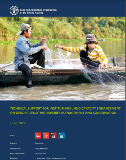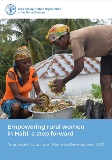TCP and Gender
Persisting inequalities between women and men are a major obstacle to agricultural and rural development. Eliminating these disparities are essential to building sustainable, inclusive food systems and resilient, peaceful societies.
FAO’s Policy on Gender Equality is centered on women having:
1. An equal voice and decision-making power
2. Equal rights, access and control over resources
3. Equal rights and access to services, markets and decent work
4. A reduction of their work burden
All projects approved under FAO’s Technical Cooperation Programme (TCP) apply the Gender Equality Policy as a key consideration in project design and implementation.
A TCP-specific gender Key Performance Indicator (KPI) is part of the 15 Minimum Standards for gender mainstreaming and women-specific targeted interventions, as defined by the FAO Policy on Gender Equality. The Standards aim to foster an enabling institutional environment by supporting the establishment of gender mainstreaming mechanisms which focus on the key functions of the Organization.
The KPI foresees that at least 60 percent of TCP projects contribute to gender equality in their implementation or have a specific gender focus. For TCP project approved against 2022-23 the share was 85 percent, and the remaining 15% were classified as having no human or social component.
Gender markers suggest that a large majority of TCP projects are mainstreamed. Here below there are examples of positive efforts being made to improve gender equality and women’s empowerment through TCPs.
Multi-Media
Latest TCP and Gender Publications

Technical Support for Institutional and Capacity Enhancement on Gender-Sensitive Fisheries Management and Conservation
06/2022
Fisheries are critically important for Cambodia. With about 32 percent of the country consisting of either permanent or seasonal wetlands, and 435 km of coastline along estuaries, bays and islands, fisheries make a large contribution to diet and livelihoods

Empowering rural women in Haiti: a step forward
02/2022
Rural women have an important role in the development of their communities. Their work at the level of groups, associations, farms, households and markets is increasingly essential and recognised by development partners.

TECHNICAL SUPPORT FOR SUSTAINABLE AGRICULTURAL MECHANIZATION OF SMALLHOLDER FARMS FOR ENHANCING AGRICULTURAL PRODUCTIVITY AND PRODUCTION, AND REDUCING DRUDGERY OF WOMEN AND YOUNG FARMERS
02/2022
Agricultural growth and productivity remain central to poverty reduction. This is particularly true in Nepal, where agriculture employs two-thirds of the labour force and provides almost one-third of the gross domestic product. Agricultural production is dominated by subsistence crop subsectors, with farms adopting a mixed farming system of crops, livestock, and agroforestry.

SUPPORT TO INCOME CREATION IN MONGOLIA (SECIM): IMPROVING LOCAL DAIRY PROCESSING THROUGH PROMOTING WOMEN
12/2019
Approximately 160 000 herder households in Mongolia process milk from horse, cow, yak, camel and goats in isolated homesteads when nomadic camps are set up.

SUPPORT TO ENHANCING THE CAPACITY OF YOUTH AND WOMEN FOR EMPLOYMENT IN AQUACULTURE
11/2019
The fisheries sector of the Gambia has long been dependent on both artisanal and industrial capture fisheries; however, productivity in this area is declining for a variety of reasons. The most notable of these are the weak enforcement of fisheries laws, the high fishing effort and climate change.



